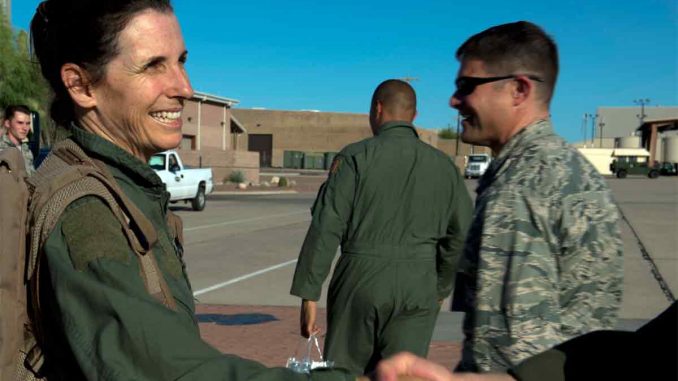
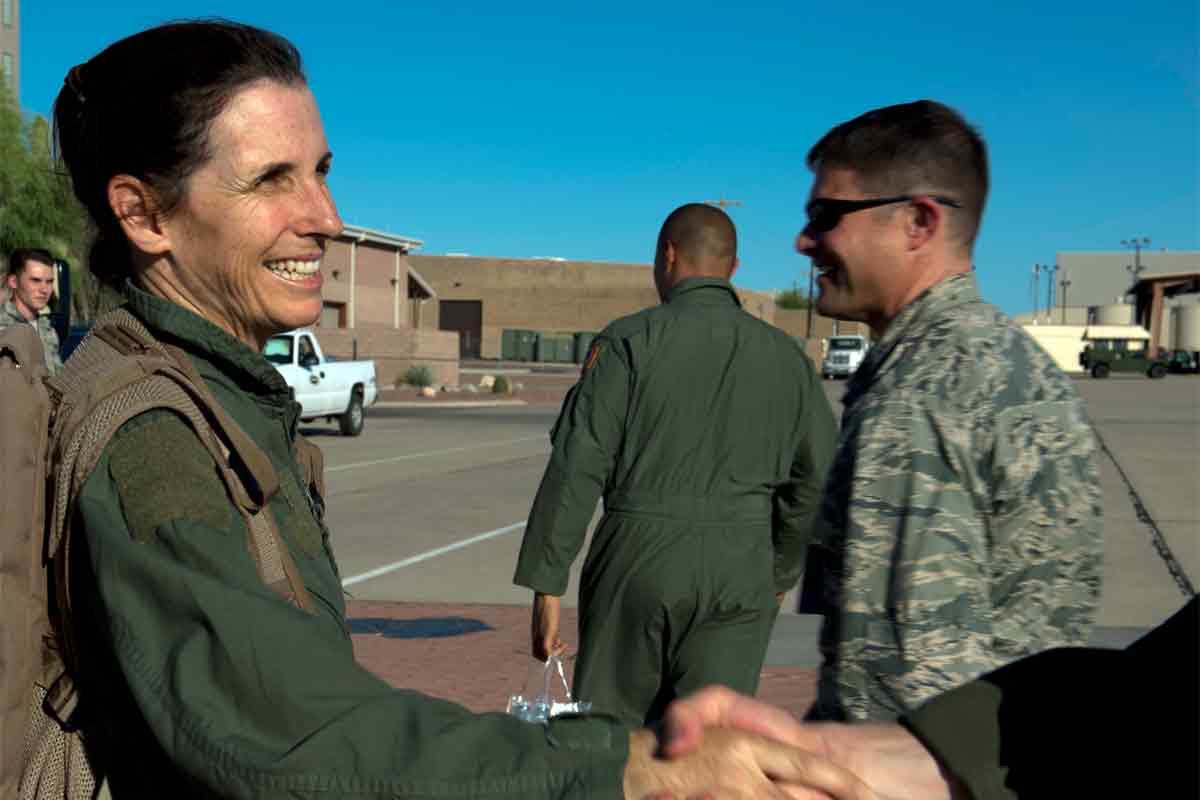
Despite her frequent criticism of the F-35 Joint Strike Fighter, Sen. Martha McSally doesn’t actually hate the aircraft.
“I love the F-35! We need the F-35!” the Republican senator from Arizona said during an interview Thursday.
Read Next: Army Shoot-Off Will Pit Israel’s Iron Dome Against Foreign Competitors
McSally is known for her fierce support of the beloved A-10 Warthog, which is the rugged opposite of the F-35.
During her time in the House, where she served from 2015 to 2019, McSally joined forces with the late Sen. John McCain to save the A-10 from mothballs, as the Air Force planned to retire the Warthog and replace it with the F-35.
She pushed for a requirement in the fiscal 2017 National Defense Authorization Act ordering a face-off between the F-35 and A-10, with each to be graded on its performance in close-air support missions.
McSally, who was the first female Air Force pilot to fly in combat, knows the requirements of close-air support. She deployed six times to locations in the Middle East, including Iraq, Kuwait and Afghanistan, where she provided cover for ground troops multiple times, firing hundreds of rounds from the A-10’s iconic Gatling gun. She flew 325 combat hours, earning a Bronze Star and six air medals, according to her official website.
McSally retired as a colonel in 2010 after serving for 22 years. She was elected to the U.S. House of Representatives in December 2014. She was appointed to the U.S. Senate in December 2018 as a replacement for McCain, but faces Democrat Mark Kelly in a bid to keep her seat — and has been sliding in the polls.
She has kept busy in the Senate, tying Sen. Chuck Grassley, R-Iowa, for the most laws enacted in 2019 — a total of seven passed in her first year as senator.
McSally spoke with Military.com about the debut of her first book, “Dare to Fly: Simple Lessons in Never Giving Up,” which explores her career in the Air Force, loss, grief, being a rape survivor, her unwavering purpose, and championing women. She launched the book along with the website daretofly.us, where readers can contact her and share their personal stories.
“We’ve got the commonality of finding our courage and dealing with grief and difficult things as human beings and even finding your wingman,” she said.
Her comments have been edited for clarity and brevity.
Military.com: You begin your book by taking readers through what it’s like taking off in the A-10 Thunderbolt II. You’ve seen the Air Force try to phase it out over the last five-plus years, or send a number of them to the boneyard. But really, how far into the future do you think the A-10 could be kept around?
Martha McSally: It’s not because I flew the A-10 that I’m trying to keep it around. It’s not nostalgia. I flew the T-37 [Tweet]. That’s in the boneyard [at Davis-Monthan Air Force Base in Tucson, Arizona]. I say “Hi” to it when I drive by the boneyard. My approach to this is that there are some circumstances where there are American troops on the ground under fire, on the move, in close proximity to friendlies, sometimes in terrain, sometimes under the weather. … They need a continuous firefight with survivability, loiter time and weapons overhead with the expertise that focuses, lives and breathes and studies close-air support. … There are some circumstances [under which] only the A-10 is going to keep Americans alive. So why would we want to get rid of that until we have a suitable alternative?
Airmen have made air superiority look easy, and we need these fifth-generation fighters in order to continue to ensure air superiority. [But] it can’t stay on station as long, it can’t take a direct hit, and you don’t want it to be in the place where, like the A-10, it’s taking a direct hit.. … And with its upgrade to the A-10C model … it’s got avionics better than some of our fourth-and-a half-generation [aircraft], and now we’re rebuilding its wings. So it’s got the ability to fly well into the 2040s, and we’re going to keep fighting to make sure it does.
The F-35 should be focusing on the things that fifth-generation fighters need to do, which is to be able to gain access against our adversaries — China and Russia and others — as they grow their capability … Asking [F-35s] to do this down and dirty mission as well … is having it be the jack of all trades, master of none.
Military.com: In your book, you discuss how you didn’t meet the height requirement to become a pilot, so you requested a waiver and appealed when it was denied many times. [With the help of Col. Chris Bell, the academy’s clinic commander at the time, and Lt. Gen Charles Hamm, superintendent of USAFA, McSally, who stands a little under 5’4″, won her appeal.] The Air Force just removed height requirements for its aviators earlier this month. Is this a sign of good things to come?
MM: So it does matter that you can fit and function in the cockpit. What I dealt with were these arbitrary bureaucratic, one-size-fits-all … limitations. I passed the cockpit fitting, I showed that I could function, but they still were saying no, and it was just ridiculous. These faceless, nameless bureaucrats who were taking my dream away, and I wasn’t going to have any of it. So this is decades overdue. Sure, you still have to be able to function, but not having the arbitrary numbers being something that’s gonna immediately disqualify somebody, especially at a time of a pilot shortage. … I think it’s great news for our Air Force, and for every individual who wants to fly, that they’ll be given a chance as an individual.
Military.com: You fall into a category of women in the military who have made their own milestones, becoming the Air Force’s first female pilot to fly in combat in 1995, and the first woman to command any combat aviation squadron, to include fighters and bombers. Are “firsts” still important?
MM: I feel extremely blessed and fortunate that I had these opportunities. The women who paved the way before me, especially the Women Airforce Service Pilots, were just amazing role models and pioneers for me. … At the time, we [our cohort] and I, speaking for myself, I was focused on doing my job right and being the best pilot that I could be and also showing that we belonged, proving those people wrong who had a maybe-not-so open mind about women joining the ranks and being a part of their team. In the military, we’re just very focused on doing our job doing it with excellence, making a difference, and we just happened to, along the way, break those barriers. I do think it matters for the next generation that they do see role models. We’ve broken through most of the barriers, right? What’s left? Chief of Staff of the Air Force? Chairman of the Joint Chiefs? And in time, that will happen.
Military.com: As you reveal in the book, at one point, you had the option to take an airlift or tanker assignment, but you instead opted to become a T-37 Instructor pilot as your first flying track. What made you push the ‘heavy’ mission aside?
MM: I just … had this dream to be a fighter pilot. So during [the assignment selection process] I just had to quickly think, ‘What is the best path for me to keep my dream alive?’ And the T-37 was the answer. And so I looked at my three base options in front of me, selected [Del Rio, Texas, home of Laughlin Air Force Base], wrote it down, handed it to my wing commander, and the rest was history. If that day I had chosen a cargo tanker, they never would have let me switch back over. Also, if I was a guy, I would have been able to pick a fighter. I didn’t have a chip on my shoulder, I had to just keep a good attitude and build my airmanship and look at the opportunities to grow as an officer and as a pilot to keep the dream. I share that whole story [in my book] as a way of saying, sometimes your plans get derailed. And a lot of people can relate to that right now in 2020, but for me, had I not been derailed, had I not been detoured. I wouldn’t have actually met my dreams and my destiny.
Military.com: Do you see yourself ever taking another job in the Air Force? Maybe as Air Force secretary, if nominated someday?
MM: Right now, I’m focused on being the best senator I could be and the opportunity to continue to serve Arizona.
Military.com: You revealed last year that you had been raped as a junior officer, and you go into that experience in the book. You also talk about the good ol’ boys climate and culture in the particularly disparaging comments made about you as a pilot just because you were a woman. Fast forward to the last year, when you petitioned the Pentagon to improve existing processes to address sexual assault, among other changes to accountability. From your experience and from what you’ve asked the Pentagon to achieve, do you think it’s enough? What still needs to be done?
MM: Let me first say, I think we’ve come a long way. And despite the painful experiences that I share in my book, I really shared them to provide hope to others who have been through it. People who know me, love me, knew these things happened to me. I just felt it was important for me to be an example to others, because this has happened to so many people in and out of the military.
Let me also say I loved my time in the Air Force. I served with so many amazing men and women who served with honor, who served with integrity who had respect for each other, and in no way do my experiences that I share characterize the vast majority of people who wear the uniform. … But one other reason that I shared this publicly last year was, oftentimes, the discussion is about what the commander’s role should be. … Having been a commander myself and a survivor myself, I’m very strongly on the side of, “Commanders need to own this. Commanders need to be responsible for preventing and holding people accountable for sexual harassment and sexual assault.” When you’re in command, you’re responsible for the lives of these men and women, you send them into harm’s way, you can put them in jail, you can take away their paycheck. As soon as we outsource it, you see that it becomes something on the sidelines. We’ve seen that with military housing, by the way, right?
So, as I pushed on the Pentagon last year, they created a task force; specifically, we were focusing on how to further improve the process once somebody reports that they have been sexually assaulted. How do you improve the investigative process? How do you improve the support to survivors? The judicial process? Oftentimes, these things are taking way too long. And it ends up being like a cancer in a unit.
Military.com: What are some things you’ve seen changing on the military’s response on sexual assault since you acted on the initiative?
MM: We’ve got 17 of the 18 initiatives that I had gotten signed into last year’s defense bill. They’re being implemented right now. I’m watching and providing oversight to see what has improved. And we’ve already seen some positive improvements, typically on the access to special victims’ counsels earlier on, as quickly as possible. … But we need to do more on the prevention side. The culture is definitely better [compared to] when I was serving in those earlier days, but I think you have a lot of well-meaning commanders who, quite frankly, are just ignorant on sexual assault. They don’t understand. They still have these stereotypes of what a predator looks like, and they can’t imagine that someone in their unit could do something like that because they look like a good officer and are a loving husband or father, but [sometimes] these are the perpetrators in plain sight.
And so I think still we need to do more and in the real education of commanders — and it starts early on as officers, early on as enlisted. Most of these crimes are happening between young people between the age of 18 and 25, and we’ve got to figure out culturally, instead of throwing more PowerPoint slides at our young airmen, we’ve got to do more for them to be able to stop these crimes among themselves, whether that’s not being facilitators [and] not being bystanders, and allow those things to be prevented.
Military.com: You’re in a heated campaign against former astronaut and ex-Navy Capt. Mark Kelly in a special election in Arizona. How does it compare to your run for the House, your career in the Air Force? What are some of the things you’ve learned from this campaign?
MM: The reason I ran for office in the first place, and I share this in my book, some people love politics for me. I’m trying to make a difference with the time I’ve been given. Having lost my dad when I was 12, I look at it like this could be the last year of my life: What am I going to do to make a difference? Also, as I share my book, don’t walk by a problem. I felt this call to duty to step up and serve in this new combat zone, because I was yelling at the television, “What’s going on with Washington D.C.?” That’s why I stepped up to run in the first place.
And I think … veterans offer that unique perspective. So it’s been an absolute honor to be able to serve in the House, and now in the Senate, I am focused on doing everything I can to support and serve the people of Arizona. The country is very divided. This is going to be a critical decision about the direction of our country. I’m in the arena. I’ve been through a lot of adversity in my life. So this is nothing like being in combat, or some of the other things [in my life] … so I’m going to just give it everything I’ve got.
Military.com: You’ve spoken to classrooms full of younger girls and boys about what it takes to be a pilot, and the opportunity of service. As the military has struggled to connect with the next-generation and refocus how it recruits, do you think that interest has fallen by the wayside?
MM: I don’t care what generation you’re in — when you go to an air show and you see planes flying, or if you live by an air base and you see them, you can’t help but look up. I didn’t want to fly until I got to the Air Force Academy. I had motion sickness when I was a kid; I thought I was going to become a military doctor. And I decided and I desired to become a fighter pilot once I found out for the first time in my life that I couldn’t do something just because I was a girl. That I couldn’t fly fighters because I was a girl, and it just made me mad. And that’s actually why I decided that’s exactly what I wanted to do. Regardless of how the younger generation is connecting or learning, being able to fly and being able to serve your country is something that is just an extraordinary opportunity. There’s many little girls or little boys with that potential and that dream in their heart. We’ve just got to connect with them in the right way.
— Oriana Pawlyk can be reached at oriana.pawlyk@military.com. Follow her on Twitter at @Oriana0214.
Related: MJ Hegar Sued the Pentagon and Won. Now She’s Running for Congress
© Copyright 2020 Military.com. All rights reserved. This material may not be published, broadcast, rewritten or redistributed.



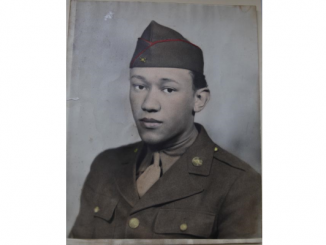
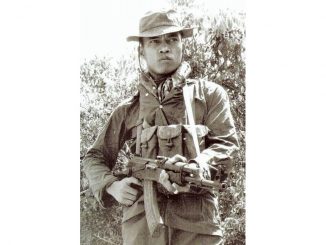
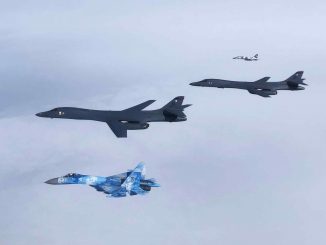
Be the first to comment